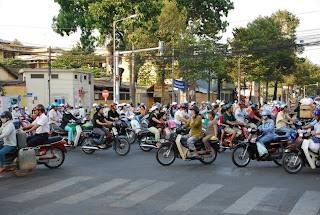(This will be repetitious to those who have been here before but it is still a new experience to some...thanks for your patience)
1. Load all passengers, scooters, etc. onto/ontop of bus (chickens now are forced to ride underneith)

2. On first class busses hand out a pastic wraped wet nap (sometimes of actual fabric) and a small bottle of water, so the customers feel refreshed after the long journey.
3. Now that everyone is loaded check the air pressure in the tires and stop at the next compressor if more is needed.
4. Once on the road make sure to honk at every possible oportunity: when you pass car, motorbike, bicycle, ox cart, tractor, 18 wheeler, cow (or other farm animal), person (old or young), any intersection. All of these honks seem to be necessary as people are a bit slower in Vietnam, than they were in Cambodia, to move over to the side of the road regardless of the speed or weight of the vehical approaching them.

5. You must also have a ticket taker on your bus, but the list of jobs of this person seems to have grown. Not only must they take tickets they must: open the door and yell to anyone standing on the side of the road who might want to get on the bus, open the door and yell at the scooters etc who were previously honked at by the driver (even reaching out to touch a few of them to make his point), sticking arm out of the window or open door to enable the driver to gauge the distance between the bus and the fully loaded truck that was being passed, and lastly the ticket taker must deliver small packages from passenger to waiting persons on the street (this must be done without stopping the bus).

6. Continue driving as quickly as possible while passing as many other entities on the road, don't stop until the specified bathroom stop...behind a resturant or until someone needs to vomit.
7. Now proceed to pass all those who happened to have passed you while you were unable to hold your position on the road.
8. Arrive at your destination and unload all luggage and passangers within 3 minutes.
Amazingly we have yet to hit anything. Wish us luck for the rest of the trip. We are going to take the train in a few days just for a change in venue.



















